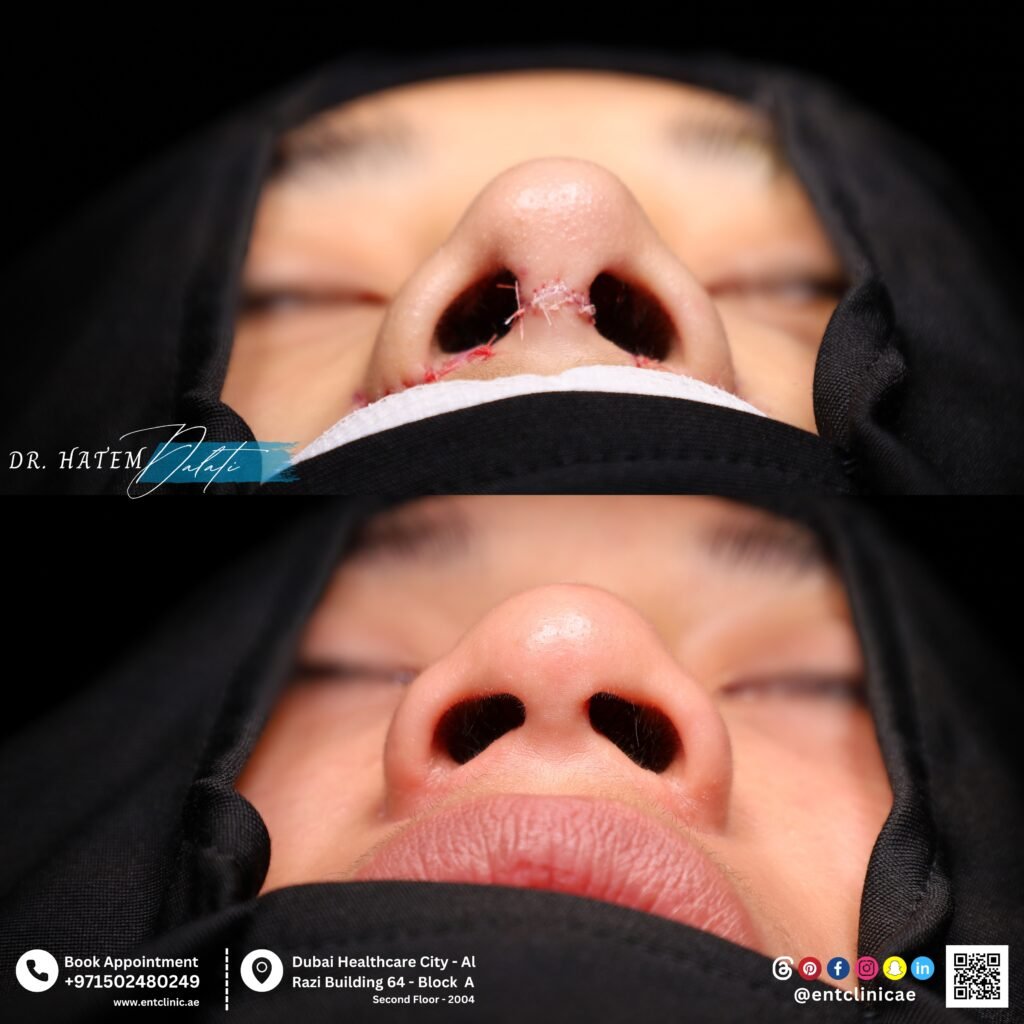
Will I Need Cartilage Grafts for My Rhinoplasty, and Where Are They Taken From?
Expert Insights by Dr. Hatem Dalati – ENT Consultant and Rhinoplasty Surgeon in Dubai
Cartilage grafts are an essential part of many rhinoplasty procedures, especially when the goal is to achieve a nose that not only looks balanced but also functions properly. Whether you’re planning a cosmetic rhinoplasty or a functional nose surgery, cartilage grafts can help create a more defined, natural, and long-lasting nasal structure.
In this article, Dr. Hatem Dalati, a highly experienced ENT consultant and rhinoplasty surgeon in Dubai, explains when cartilage grafts are needed, where they are sourced, and how he ensures safety and natural results using DHA-approved graft materials when appropriate.
When Are Cartilage Grafts Needed in Rhinoplasty?
Cartilage grafts are used to support, reshape, or rebuild parts of the nose that need reinforcement. They are particularly beneficial in:
- Functional rhinoplasty to improve breathing or correct nasal valve collapse.
- Revision rhinoplasty (corrective surgery after a previous nose job).
- Nasal tip refinement or structural enhancement for cosmetic balance.
- Cases with weak or insufficient nasal cartilage.
Dr. Hatem Dalati emphasizes that grafts are vital in maintaining both nasal aesthetics and long-term stability, ensuring your results look natural and age gracefully.
Where Is the Cartilage Taken From?
The source of cartilage depends on the type of correction needed and the patient’s available tissue.
- Septal Cartilage (from inside the nose)
- Most commonly used source.
- Ideal for primary rhinoplasty and minor reshaping.
- Taken from the nasal septum — the wall between the nostrils.
- Ear Cartilage (Conchal Cartilage)
- Harvested from behind the ear, leaving no visible scar.
- Used for refining the nasal tip or minor contour adjustments.
- Rib Cartilage (Costal Cartilage)
- Suitable for complex or revision rhinoplasty requiring extra support.
- Taken from a small incision near the chest.
Use of DHA-Approved Cartilage Grafts
In addition to using the patient’s own cartilage (autologous grafts), Dr. Hatem Dalati may also utilize DHA-approved available cartilage graft materials when suitable. These biocompatible options meet the Dubai Health Authority’s strict safety and quality standards, providing reliable structural support for patients who may not have enough natural cartilage.
This approach allows for:
- Safer procedures following DHA medical regulations.
- Reduced need for additional incisions (when autologous cartilage is insufficient).
- Consistent and predictable results with approved materials.
For patients curious about synthetic implants, you can read more in our detailed guide:
👉 What Are Gore-Tex Implants? Why We Use Natural Cartilage in Dubai ENT Surgery | Best ENT Clinic in Dubai 👃🌿
Gore-Tex Implants vs Cartilage: What’s the Difference?
| Gore-Tex Implants | Natural Cartilage Grafts |
|---|---|
| Synthetic material (expanded polytetrafluoroethylene) | Taken from your own body (nose, ear, or rib) or DHA-approved cartilage |
| Provides instant shape and volume, commonly used for nasal bridge augmentation | Integrates naturally with nasal tissues for long-term stability |
| Smooth and easy to mold during surgery | Biocompatible and low risk of rejection |
| Slightly higher risk of infection or extrusion if not monitored properly | Highly safe, especially when using DHA-approved cartilage |
| May feel firmer over time compared to natural tissue | Feels soft and natural, blending seamlessly with the rest of the nose |
Dr. Hatem Dalati prefers using natural cartilage or DHA-approved cartilage grafts to ensure safe, natural-looking, and long-lasting results that fully comply with Dubai Health Authority (DHA) standards.
Benefits of Cartilage Grafts in Rhinoplasty
- Enhances both form and function of the nose.
- Provides natural-looking contours.
- Improves breathing when nasal support is restored.
- Low risk of rejection or infection when using DHA-approved materials.
- Ensures long-term stability and a smooth nasal profile.
Frequently Asked Questions (FAQs)
1. Are cartilage grafts safe in rhinoplasty?
Yes. Dr. Hatem uses either your own cartilage or DHA-approved available grafts, both proven safe and biocompatible.
2. Will grafts affect recovery time?
Recovery is typically similar to regular rhinoplasty. If rib or ear cartilage is used, healing of the donor site takes just a bit longer.
3. What makes DHA-approved grafts different?
These are pre-screened and certified materials that meet DHA safety standards, minimizing risks while maintaining surgical precision.
4. Can grafts improve breathing as well as appearance?
Absolutely. Functional rhinoplasty often relies on cartilage grafts to open nasal passages and improve airflow, enhancing both comfort and appearance.
Expert Opinion from Dr. Hatem Dalati
Each nose is unique, and the need for cartilage grafts depends on your nasal anatomy, previous surgeries, and goals. During your consultation, Dr. Hatem Dalati will assess the best option — whether using your own cartilage or a DHA-approved available graft — to achieve a natural, well-balanced, and functional result.
To learn more about his expertise and approach, visit:
👉 Why Dr. Hatem Dalati Is the Best Choice for Rhinoplasty in Dubai
📞 Book Your Consultation with Dr. Hatem Dalati Today
Considering rhinoplasty in Dubai? Discover whether cartilage grafts are right for you with Dr. Hatem Dalati, expert ENT consultant and rhinoplasty surgeon, known for creating refined, natural results using safe, DHA-approved techniques.
📍 Location: ENT Clinic of Excellence, Dubai Healthcare City
📞 Contact Us on WhatsApp: +971 50 248 0249 (WhatsApp)
🌐 Visit our website: entclinic.ae
📱 Follow us for more ENT & Rhinoplasty insights: Instagram | YouTube | TikTok